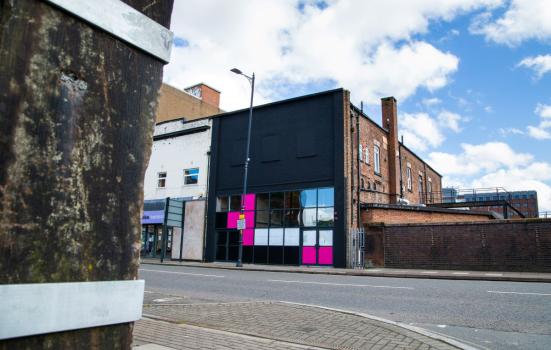Covid was a challenging time for live music. But that didn’t stop Future Yard, a new live music venue in Birkenhead, from opening its doors - with the help of a loan - as Director Craig Pennington tells Seva Phillips.

Robin Clewley
Future Yard opened at a point when the pandemic had taken its toll on the music industry, safety measures like social distancing had reduced the capacity for audiences, and a precarious workforce was feeling the effects of successive lockdowns.
In this context, as a social enterprise, Future Yard’s aim was to use music as a force for good in Birkenhead and the Wirral, with ambitions to reimagine totally the role of a community music venue.
Alongside a busy programme of new music talent, Future Yard hosts an artist development hub with free skills training programmes to enable young people to pursue careers in the music industry.
‘Why we get out of bed in the morning’
Craig spoke to me about the venue’s inspiring journey. His central question was: “How do you reimagine a community venue as a real driver of meaningful social change? We believe music can change the world. That’s why we get out of bed in the morning.”
“Birkenhead has an amazing musical heritage. A lot of artists who people think of as from Liverpool are actually from Birkenhead and the Wirral peninsula. But we haven’t had a live music venue dedicated to supporting emerging talent in this town for thirty years.”
The unique challenges of the area, often in the shadow of neighbouring Liverpool, cemented Craig’s ambition to do something for the area. “Our ward is in the bottom 1% measured through the indices of multiple deprivation,” he explains. “We had a tough time during the 1980s, a similar story to Glasgow with the decline of ship building, and real issue with a heroin epidemic.”
The area has a unique character, he adds. “We’ve got a great mix of writers, actors, musicians – a very rich and diverse artistic and creative heritage, but also a complete lack of investment in the structures and support services around that.”
‘Getting green shoots moving’
In 2018, Craig and the team received seed funding from Kindred to run a pilot project, a run of shows which also offered mentoring support. It was a way, he says, of “getting some green shoots moving, to see if the audiences were there and if artists wanted to play in the town.”
Enthused by the positive response, they developed a festival in 2019. “The festival was a massive case study, a big test,” he explains. Using historic landmark buildings like Birkenhead Priory, they programmed artists including Anna Calvi, Dry Cleaning and Working Men’s Club to an audience of 2,000 people.
“It made us realise that not only was there an audience, but there was a group of local people who were passionate about Birkenhead as a town, that hadn’t necessarily been given the opportunity to be enthusiastic about it before.
” Future Yard’s defining slogan - The Future is Birkenhead - grew out of that civic pride. “It was a messy kind of project kickstart in many ways,” adds Craig, but hugely rewarding and really valuable in our journey.”
Galvanised by the experience of the festival, the team wanted to take things to a new level. “The festival was brilliant, but it was only one weekend,” Craig continues. “We wanted a space 365 days of the year to drive this change.”
Ownership has provided security
Stability was important. “We knew we ideally wanted a front door that we could open seven days a week as well as the live space. The needs of the physical asset were quite specific. And then we found this building we are now in, which is in the centre of Birkenhead.”
Covid brought a period of forced experimentation, with a need to embrace risk-taking in programming. But soon they realised they had to buy the building to have the security they needed. And the building was on the market.
Future Yard approached the Arts & Culture Impact Fund for a secured loan towards its purchase. “Gentrification and people living in city centres doesn’t correlate with a great independent live music scene,” says Craig. “So, we wanted to own somewhere and not have a landlord use us to push the value of our asset, then flip us out.”
Owning the building has been an opportunity to secure the organisation’s future, strengthening their asset base and enabling them to invest in capital works to keep the building going as a high-quality destination.
New opportunities
Financial security through social investment has meant Future Yard hasn’t had to compromise on their aims or the social impact of their work. Deep benefits to the local community have been integral to the project from the outset.
Their Soundcheck programme is about “opening the venue up and thinking of how every professional role could be a learning opportunity for a young person.” The team were mindful that the music industry and live music jobs were usually the preserve of those with higher education or allowed to learn on the job.
Soundcheck has supported 200 young people, offering training and placements and recruiting paid members of the team. “The model is specifically designed to create opportunities.”
Normalising cultural experiences
Partnership working with the third sector is also important, engaging local groups and charities. The organisation also runs kids’ gigs - Mosh Tots – giving children their first experience of live music. It also offers local families the opportunity to “have a cultural experience as a family.”
Future Yard distributes free tickets to local primary schools - and is thrilled to see those families returning. It also offers children opportunities to join programmes as they get older, normalising cultural experiences and arts careers in an area where they have previously not been absent.
The team were aware that arts can be used negatively to drive gentrification, so they actively designed Future Yard to operate differently - bottom-up rather than top-down. “What would terrify me more than anything is the idea that Future Yard is a kind of hipster commune, disconnected from local people,” Craig explains. “Because that couldn't be further from our motivation. I don’t think people view us like that.”
“The core model,” he adds, “the underlying idea, is that it’s based in people. And a real steadfast unwavering belief that we can be a positive change.” The community has been key to Future Yard’s success: “It feels like there's a lot of love and a lot of support. People have our back.”
Craig Pennington, Director of Future Yard was talking to Seva Phillips, Head of Arts & Culture Finance at Nesta.
![]() artsculturefinance.org | futureyard.org
artsculturefinance.org | futureyard.org
![]() @artsculturefin | @future_yard
@artsculturefin | @future_yard
This interview is an extract of a longer one with Craig Pennington that features in Arts & Culture Finance’s podcast series.
This article, sponsored and contributed by Arts & Culture Finance, is one of series demonstrating the impact repayable finance can make to the arts, culture and heritage sector.






